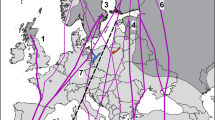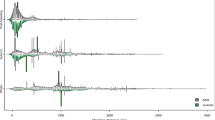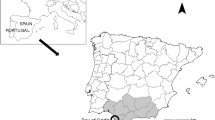Abstract
Differential migration reflects various constraints and selective forces on different individuals in a population, and has been explained by several hypotheses. Most previous studies about differential migration focused on only one aspect (e.g. spring timing, autumn timing or wintering area), which could not give a full picture of differential migration of the study population and carry out an overall investigation into the hypotheses. In this study, we analyse the migration patterns of European Ospreys Pandion haliaetus ringed in Germany based on the ring recovery database between 1980 and 2008. The migration routes of the study population form a broad front between south and southwest of the ringing area, and the wintering sites are in West Africa south of the Sahara and around the western Mediterranean. We demonstrate differential migration of the population in both spring and autumn timings as well as in the use of wintering grounds. Adult (third year and older) males return earliest to the breeding area in spring, followed by adult females and then two-year-old birds. In autumn, the adult females leave the breeding area earlier than adult males, while the migration of first-year Ospreys takes place over a wide time-span. Adult males were discovered mainly around the western Mediterranean in winter, closer to the ringing area than adult females and younger birds. We suggest that the selection for prior access to breeding resources on males shapes the patterns of differential migration in Ospreys.
Zusammenfassung
Der differenzierte Zug von Vögeln spiegelt verschiedene Selektionsfaktoren wider, die auf Individuen einer Population unterschiedlich einwirken. Er wurde mit mehreren Hypothesen erklärt, wobei die meisten bisherigen Untersuchungen über differenzierten Zug sich nur auf einen Aspekt (z. B. Frühjahrszug, Herbstzug, Überwinterungsgebiet) konzentrierten. Dadurch konnte kein Gesamtbild des Zuggeschehens einer untersuchten Population und keine umfassende Überprüfung der Hypothesen erreicht werden. Mit unserer Untersuchung analysieren wir das Zugmuster von in Deutschland über die Jahre 1980 bis 2008 nestjung beringten Fischadlern Pandion haliaetus, die in der Wiederfund-Datenbank der Beringungszentrale Hiddensee gespeichert sind. Die Zugwege der untersuchten Population verlaufen ausgehend vom Beringungsgebiet auf breiter Front zwischen südlichen und südwestlichen Richtungen. Die Überwinterungsgebiete liegen im Westen Afrikas südlich der Sahara und im westlichen Mittelmeergebiet. Wir zeigen auf, dass die Fischadler sowohl im zeitlichen Ablauf im Herbst als auch im Frühjahr einem differenzierten Zug unterliegen, genauso wie bei der räumlichen Nutzung des Überwinterungsgebietes. Adulte Männchen (3-jährige und ältere) kehren im Frühjahr zuerst ins Brutgebiet zurück, gefolgt von adulten Weibchen und dann von zweijährigen Vögeln. Im Herbst verlassen adulte Weibchen das Brutgebiet früher als adulte Männchen, wobei sich der Zug der Jungvögel noch über einen längeren Zeitraum erstreckt. Adulte Männchen wurden im Winter überwiegend im westlichen Mittelmeerraum und damit näher zum Brutgebiet gelegen gefunden als adulte Weibchen und jüngere Fischadler. Wir gehen davon aus, dass die Selektion, einen möglichst frühzeitigen Zugang zu den Brutplätzen zu erhalten, vorwiegend auf Männchen wirkt und damit das Muster des differenzierten Zuges bei Fischadlern formt.



Similar content being viewed by others

References
Alerstam T, Hake M, Kjellén N (2006) Temporal and spatial patterns of repeated migratory journeys by ospreys. Anim Behav 71:555–566
Bai ML, Schmidt D, Gottschalk E, Mühlenberg M (2009) Distribution pattern of an expanding Osprey (Pandion haliaetus) population in a changing environment. J Ornithol 150:255–263
Berthold P (2001) Bird migration. A general survey. Oxford University Press, Oxford
Bildstein K (2006) Migrating raptors of the world—their ecology and conservation. Cornell University Press, London
Cristol DA, Baker MB, Carbone C (1999) Differential migration revisited: latitudinal segregation by age and sex class. Curr Ornithol 15:33–88
DeLong J, Hoffman SW (1999) Differential autumn migration of sharp-shinned and Cooper’s hawks in western North America. Condor 101:674–678
Dennis R (2008) A life of ospreys. Whittles, Caithness
Evans DM, Day KR (2001) Migration patterns and sex ratios of diving ducks wintering in Northern Ireland with specific reference to Lough Neagh. Ringing Migr 20:358–363
Fernandez G, Lank DB (2007) Variation in the wing morphology of Western Sandpipers (Calidris mauri) in relation to sex, age class, and annual cycle. Auk 124:1037–1046
Fransson T, Pettersson J (2001) Swedish bird ringing atlas vol. 1. Divers—raptors. Swedish museum of natural history, Stockholm
Gauthreaux SA (1982) The ecology and evolution of avian migration systems. Avian Biol 6:93–168
Gillis EA, Green DJ, Middleton HA, Morrissey CA (2008) Life history correlates of alternative migratory strategies in American dippers. Ecology 89:1687–1695
Guillemain M, Hearn R, King R, Gauthier-Clerc M, Simon G, Caizergues A (2009) Differential migration of the sexes cannot be explained by the body size hypothesis in Teal. J Ornithol 150:685–689
Hake M, Kjellén N, Alerstam T (2001) Satellite tracking of Swedish ospreys Pandion haliaetus: autumn migration routes and orientation. J Avian Biol 32:47–56
Jenkins KD, Cristol DA (2002) Evidence of differential migration by sex in white-throated sparrows (Zonotrichia albicollis). Auk 119:539–543
Kerlinger P (1989) Flight strategies of migrating hawks. University of Chicago press, Chicago
Ketterson ED, Nolan V Jr (1976) Geographic variation and its climatic correlates in the sex ratio of eastern-wintering dark-eyed juncos (Junco hyemalis hyemalis). Ecology 57:679–693
Ketterson ED, Nolan V Jr (1983) The evolution of differential bird migration. Curr Ornithol 1:357–402
Kjellén N, Hake M, Alerstam T (2001) Timing and speed of migration in male, female and juvenile ospreys Pandion haliaetus between Sweden and Africa as revealed by field observations, radar and satellite tracking. J Avian Biol 32:57–67
Kokko H (1999) Competition for early arrival in migratory birds. J Anim Ecol 68:940–950
Loi V, Pisano S (2006) Svernamento di Falco pescatore Pandion haliaetus di origine tedesca in Sardegna. Alula 13:201–203
Lyons JE, Collazo JA, Guglielmo CG (2008) Plasma metabolites and migration physiology of semipalmated sandpipers: refueling performance at five latitudes. Oecologia 155:417–427
Martell MS, Henny CJ, Nye PE, Solensky MJ (2001) Fall migration routes, timing, and wintering sites of North American ospreys as determined by satellite telemetry. Condor 103:715–724
Mazerolle DF, Hobson KA (2007) Patterns of differential migration in white-throated sparrows evaluated with isotopic measurements of feathers. Can J Zool 85:413–420
Mebs T, Schmidt D (2006) Die Greifvögel Europas, Nordafrikas und Vorderasiens—Biologie, Kennzeichen, Bestände. Kosmos, Stuttgart
Mills AM (2005) Protogyny in autumn migration: do male birds ‘play chicken’? Auk 122:71–81
Morris SR, Pusateri CR, Battaglia KA (2003) Spring migration and stopover ecology of common yellowthroats on Appledore Island, Maine. Wilson Bull 115:64–72
Morton ML (1984) Sex and age ratios in wintering white-crowned sparrows. Condor 86:85–87
Myers JP (1981) A test of three hypotheses for latitudinal segregation of the sexes in wintering birds. Can J Zool 59:1527–1534
Nilsen R, Gutvik OK, Nilssen EM, Hopkins CCE (1989) Population parameters of the witch flounder Glyptocephalus cynoglossus (L.) (Pisces: Pleuronectidae) from Malangen, northern Norway. Fish Res 12:259–278
O’Hara PD, Fernandez G, Haase B, de la Cueva H, Lank DB (2006) Differential migration in western sandpipers with respect to body size and wing length. Condor 108:225–232
Payevsky VA (1995) Differential wintering and survival rates of age and sex groups in some species of finches. Zool Zh 74:129–135
Poole AF (1989) Osprey: a natural and unnatural history. Cambridge University Press, Cambridge
Prescott DRC, Middleton ALA (1990) Age and sex differences in winter distribution of American goldfinches in eastern North America. Ornis Scanda 21:99–104
Prevost YA (1982) The wintering ecology of ospreys in Senegambia. Dissertation, University of Edinburgh
Roepke D (1996) Fünfzehn Jahre Beringungsarbeit am Fischadler (Pandion. h. haliaetus). Naturschutzarb Mecklenburg-Vorpommern 39:22–35
Rogers CM, Theimer TL, Nolan V Jr, Ketterson ED (1989) Does dominance determine how far dark-eyed juncos, Junco hyemalis, migrate into their winter range? Anim Behav 37:498–506
Saurola P (1994) African non-breeding areas of Fennoscandian ospreys Pandion haliaetus: a ring recovery analysis. Ostrich 65:127–136
Schmidt D (1995) Beringung nestjunger Fischadler Pandion haliaetus in Ostdeutschland mit Farbkennringen. Ber Vogelw Hiddensee 12:133–136
Schmidt D (2009) 15 Jahre Farbberingung von Fischadlern Pandion haliaetus in Deutschland. Ber Vogelw Hiddensee 19:47–52
Schmidt D (2010) Der Brutbestand des Fischadlers Pandion haliaetus in Deutschland im frühen 21. Jahrhundert. Charadrius 46:10–17
Schmidt D, Meyburg B-U (1998) Forschung an Fischadlern (Pandion haliaetus) im strelitzer land. Labus (Neustrelitz). Neue Reihe 8:22–27
Schmidt D, Roepke D (2001) Zugrouten und Überwinterungsgebiete von in Deutschland beringten Fischadlern Pandion haliaetus. Vogelwelt 122:141–146
Schmidt D, Rochus Chr, Jackson F (2000) Methoden zur Bestimmung der Körpermasse von Fischadlern Pandion haliaetus. Populationsökol Greifvogel Eulenarten 4:143–152
Schmidt D, Herold S, Lange H, Reusse P (2006) Zur Philopatrie des Fischadlers Pandion haliaetus in Deutschland—Zwischenergebnisse des Farbringprogramms 1995–2004. Populationsökol Greifvogel Eulenarten 5:133–142
Stewart BS (1997) Ontogeny of differential migration and sexual segregation in northern elephant seals. J Mammal 78:1101–1116
Stewart RLM, Francis CM, Massey C (2002) Age-related differential timing of spring migration within sexes in passerines. Wilson Bull 114:264–271
Strandberg R, Klaassen RHG, Thorup K (2009) Spatio-temporal distribution of migrating raptors: a comparison of ringing and satellite tracking. J Avian Biol 40:500–510
Thorup K, Alerstam T, Hake M, Kjellén N (2003) Can vector summation describe the orientation system of juvenile ospreys and honey buzzards?—An analysis of ring recoveries and satellite tacking. Oikos 103:350–359
Weber M, Schmidt D, Haedrich J (2003) Chlororganische Rückstände in Eiern des Fischadlers (Pandion haliaetus) aus Deutschland. J Ornithol 144:45–58
Woodrey MS, Chadler CR (1997) Age-related timing of migration: geographic and interspecific patterns. Wilson Bull 109:52–67
Acknowledgments
We are grateful to Dr. R Strandberg for sharing his expert knowledge which has enriched the manuscript. We thank especially all the volunteer ringers and their teams who have worked hard for many years to make this publication possible: Dr. M. Dornbusch, H. Gabriel, P. Hauff, S. Herold, Dr. P. Kneis, W. Köhler, M. Kuhnert, G. Lohmann, Dr. R. Möckel, P. Reuße, D. Roepke, Ch. Scharnweber and P. Sömmer. We are also grateful to those who reported sightings of ringed Ospreys. The following nest wardens and coordinators made it possible that D. Schmidt could ring many Osprey nestlings: M. Dittrich, B. Ewert, M. Graef, E. Hemke, B. Heuer, H. Lange, O. Manowsky, K. Ridder, G. Röber und D. Ruhle. R. Wahl provided the information about the Ospreys breeding in France. H. Dansberg produced the coded colour-rings and ringing instruments. The Forestry and Nature Conservation authorities, the Hiddensee Bird Ringing Centre, the power companies enviaM, E.ON edis and Vattenfall Europe Transmission and the DB Energie GmbH supported the ringing. Most of the work of D. Schmidt was funded by the Adler Modemärkte Haibach and the Deutsche Ornithologen-Gesellschaft (DO-G). This study complies with the current laws in Germany.
Author information
Authors and Affiliations
Corresponding author
Additional information
Communicated by F. Bairlein.
This is the ring recovery report no. 4/2011 of the Hiddensee Bird Ringing Centre.
Rights and permissions
About this article
Cite this article
Bai, ML., Schmidt, D. Differential migration by age and sex in central European Ospreys Pandion haliaetus . J Ornithol 153, 75–84 (2012). https://doi.org/10.1007/s10336-011-0697-y
Received:
Revised:
Accepted:
Published:
Issue Date:
DOI: https://doi.org/10.1007/s10336-011-0697-y



